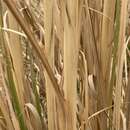Comments
provided by eFloras
This is a very large tufted grass which is of little account as a fodder plant since cattle and buffaloes will only eat the tender young leaves. A valuable fibre can be extracted from the upper leaf-sheaths of the flowering culm.
- license
- cc-by-nc-sa-3.0
- copyright
- Missouri Botanical Garden, 4344 Shaw Boulevard, St. Louis, MO, 63110 USA
Description
provided by eFloras
Tall caespitose perennial; culms up to 4 m high. Leaf-blades up to 90 cm long, 3-10 mm wide, flat or markedly channelled, the midrib occupying the greater part of the width, glaucous. Panicle 20-75 cm long, the peduncle glabrous; racemes 2-4(-5) cm long, considerably shorter than the supporting branches, the internodes and pedicels hirsute with hairs up to 7 mm long. Spikelets slightly heteromorphous, 3.8-5.5 mm long, the callus bearded with whitish or greyish hairs up to 2.5 mm long; glumes equal, membranous, lower glume of sessile spikelet hairy on the back, the upper glume glabrous, both glumes of pedicelled spikelet hairy, the hairs at least 4 mm long, often up to 9 mm; lower lemma oblong-elliptic, hairy on the back; upper lemma ovate-lanceolate, ciliate on the margins, acute or very shortly awned, the awn not visible beyond the glumes.
- license
- cc-by-nc-sa-3.0
- copyright
- Missouri Botanical Garden, 4344 Shaw Boulevard, St. Louis, MO, 63110 USA
Distribution
provided by eFloras
Distribution: Pakistan (Sind, Punjab & N.W.F.P.); North and Northwest India; ? Afghanistan.
- license
- cc-by-nc-sa-3.0
- copyright
- Missouri Botanical Garden, 4344 Shaw Boulevard, St. Louis, MO, 63110 USA
Physical Description
provided by USDA PLANTS text
Perennials, Terrestrial, not aquatic, Stems nodes swollen or brittle, Stems erect or ascending, Stems caespitose, tufted, or clustered, Stems terete, round in cross section, or polygonal, Stem nodes bearded or hairy, Stem internodes solid or spongy, Stems with inflorescence 2-6 m tall, Stems, culms, or scapes exceeding basal leaves, Leaves mostly cauline, Leaves conspicuously 2-ranked, distichous, Leaves sheathing at base, Leaf sheath mostly open, or loo se, Leaf sheath smooth, glabrous, Leaf sheath and blade differentiated, Leaf blades linear, Leaf blades 2-10 mm wide, Leaf blades 1-2 cm wide, Leaf blades 2 or more cm wide, Leaf blades mostly flat, Leaf blades mostly glabrous, Leaf blades scabrous, roughened, or wrinkled, Leaf blades glaucous, blue-green, or grey, or with white glands, Ligule present, Ligule a fringed, ciliate, or lobed membrane, Inflorescence terminal, Inflorescence an open panicle, openly paniculate, branches spreading, Inflorescence a dense slender spike-like panicle or raceme, branches contracted, Inflorescence solitary, with 1 spike, fascicle, glomerule, head, or cluster per stem or culm, Inflorescence branches more than 10 to numerous, Flowers bisexual, Spikelets pedicellate, Spikelets sessile or subsessile, Spikelets dorsally compressed or terete, Spikelet less than 3 mm wide, Spikelets with 1 fertile floret, Spikelets with 2 florets, Spikelets paired at rachis nodes, Spikelets all alike and fertill e, Spikelets in paired units, 1 sessile, 1 pedicellate, Spikelets bisexual, Inflorescence disarticulating between nodes or joints of rachis, rachis fragmenting, Spikelets disarticulating below the glumes, Spikelets falling with parts of disarticulating rachis or pedicel, Inflorescence branches deciduous, falling intact, Spikelets conspicuously hairy , Rachilla or pedicel hairy, Glumes present, empty bracts, Glumes 2 clearly present, Glumes equal or subequal, Glumes equal to or longer than adjacent lemma, Glume surface hairy, villous or pilose, Glumes 1 nerved, Lemmas thin, chartaceous, hyaline, cartilaginous, or membranous, Lemma 3 nerved, Lemma apex acute or acuminate, Lemma mucronate, very shortly beaked or awned, less than 1-2 mm, Lemma margins thin, lying flat, Lemma straight, Callus or base of lemma evidently hairy, Callus hairs shorter than lemma, Stamens 3, Styles 2-fid, deeply 2-branched, Stigmas 2, Fruit - caryopsis.
Tripidium bengalense: Brief Summary
provided by wikipedia EN
Tripidium bengalense, synonym Saccharum bengalense, with the common names munj sweetcane, baruwa sugarcane or baruwa grass, is a plant of the genus Tripidium native to Iran, Afghanistan, Pakistan, Northern India, Nepal, Bangladesh and Myanmar.
A primary native distribution area is northeastern India, particularly in Assam within the Terai-Duar grasslands in the foothills of the Himalayas.
- license
- cc-by-sa-3.0
- copyright
- Wikipedia authors and editors

